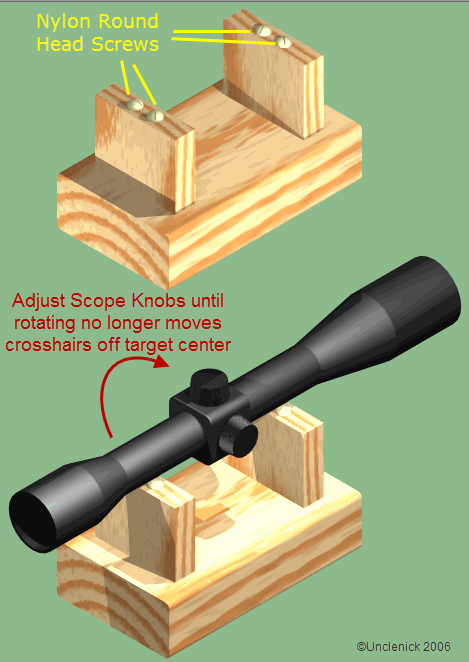First, for zeroing your scope mechanically, here's a simple fixture you can build for yourself from some scrap two-by-fours and four round-head Nylon bolts. The last time I made one of these for somebody, I drilled the bolt holes to full diameter and used hot melt glue to set the bolts into the wood so the screwdriver slots were kept parallel to the scope tube, unlike in the illustration, and wouldn't be part of the bearing surface:
Once you have the scope mechanical zero, the advice of the others holds. I use a laser bore sighter, but once the crosshairs are on the dot, I rotate the sighter in the bore 180 degrees, then look to see how far off it is. I then adjust the scope half way between the starting point and the second laser position. That's usually very close to correct.
Bore sighting works, too, but it takes a bit more getting used to.
Use a very large target backer to shoot the square Nathan suggested to see if the scope comes back. That, or, just leave it at the mechanical zero and shoot at 50 yards and see if the ammo plays nicely with you.
The Winchester brass I have has about a grain and a half less water overflow capacity than the Federal brass I have. This means I need about 0.8-0.9 grains more powder in the Winchester case to reach the same pressure and barrel time range using the same bullet and primer. However, that case overflow capacity ratio has changed over time with brass lots, so you need to measure it for your own case lots as fired in your own chamber. This must be done before you resize them, as the expanded volume is what determines peak pressure, not the resized volume. Then figure about 0.6 to 0.7 grains of powder charge increase for for each grain additional case water overflow capacity a case has.
I have an old
Excel file you can download here that includes instructions and will assist with making this measurement. It works with the
free Open Office Suite's spreadsheet program (Calc) as well as with Excel.
It should go without saying that if your gun needs bedding to stop uneven or biased or irregular contact between the wood and the barrel, or if it needs its muzzle recrowned, or needs its action and bolt face trued to reduce heat walking, or needs its bolt lugs lapped, you are not likely to get it to shoot up to its potential until these things are taken care of.


